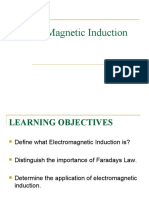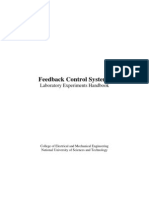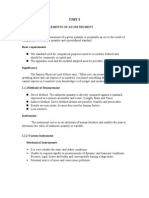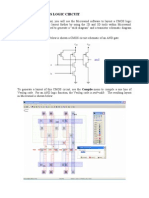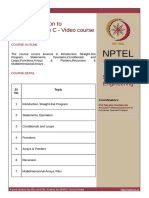FeedCon (Unit 1)
FeedCon (Unit 1)
Uploaded by
Melissa LindayagCopyright:
Available Formats
FeedCon (Unit 1)
FeedCon (Unit 1)
Uploaded by
Melissa LindayagOriginal Title
Copyright
Available Formats
Share this document
Did you find this document useful?
Is this content inappropriate?
Copyright:
Available Formats
FeedCon (Unit 1)
FeedCon (Unit 1)
Uploaded by
Melissa LindayagCopyright:
Available Formats
Feedback and Control Systems
INTRODUCTION TO FEEDBACK CONTROL SYSTEMS 1.1 Definition of Terms, Basic Concepts and History Control systems are integral part of modern society. Numerous applications are all around: The rockets fire, and the space shuttle lifts off to earths orbit; in splashing cooling water, a metallic part is automatically machined; a self-guided vehicle delivering material to workstations in an aerospace assembly plant glides along the floor seeking its destination. We are not only creators of automatically controlled systems; these systems also exist in nature. Within our bodies are numerous control systems. Even the nonphysical world appears to be automatically regulated. A control system consists of subsystems and processes (or plants) assembled for the purpose of obtaining a desired output with desired performance given a specified input. Figure 1.1 shows a simplified description of a control system.
Figure 1.1. Simplified description of a control system
Consider an elevator. When fourth-floor button is pressed on the first floor (specified input), the elevator rises to the fourth floor with a speed and floor-leveling accuracy designed for passenger comfort. The performance of the elevator can be seen from the elevator response curve in Figure 1.2.
Figure 1.2. Elevator response curve
Complex Numbers and Complex Functions
Page 1
Feedback and Control Systems
Two major measures of performance can now be seen from this figure: The transient response The steady-state error
With control systems, we can move large equipment with precision, point huge antennas towards the farthest reaches of the universe to pick up faint radio signals, elevators carry us quickly to our destination, automatically stopping at the right floor. Control systems are built for four primary reasons: Power amplification Remote control Convenience of input form Compensation for disturbances
1.2 History of Control Systems Liquid-Level Control. Greeks first engineered control systems around 300 BC. A water clock invented by Ktesibios operated by having water trickle into a measuring container at a constant rate. The level of water can be used to tell time, provided the supply tank had to be kept at a constant level. This was accomplished by using a float valve similar to the water-level control in todays flush toilets. Liquid-level control was also applied to an oil lamp by Philon of Byzantium. Steam Pressure and Temperature Controls. Regulation of steam pressure began around 1681 with Denis Papins invention of the safety valve. The concept was further elaborated on by weighting the valve top. Also in the 17th century, Cornelis Drebbel in Holland invented a purely mechanical temperature control system for hatching eggs. Speed Control. In 1745, speed control was applied to a windmill by Edmund Lee. William Cubitt improved on the idea in 1809. In 18th century, James Watt invented the flyball speed governor to control the speed of steam engines. Stability, Stabilization, and Steering. Control systems theory as we know it today began to crystallize in the latter half of the 19th century. In 1868, James Clerk Maxwell published the stability criterion for a thirdorder system based on the coefficients of the differential equations. In 1874, Edward John Routh, using a suggestion from William Kingdon Clifford that was ignored earlier by Maxwell, was able to extend the stability criterion to fifth-order systems. Two papers, The Criterion for Dynamical Stability in 1877, and A Treatise on the Stability of a Given State of Motion by Routh are now the basis of what is known as the Routh-Hurwitz stability criterion for control systems. Alexandr Michailovich Lyapunov, a student of Chebyshev, extended the work of Routh to nonlinear systems in 1892. During the second half of 1800s the development of control systems focused on the steering and stabilizing of ships. In 1874, Henry Bessemer used a gyro to sense a ships motion to keep the stability of ships.
Complex Numbers and Complex Functions
Page 2
Feedback and Control Systems
Twentieth-Century Developments. It was not until early 1900s that automatic steering of ships was achieved. In 1922, the Sperry Gyroscope Company installed an automatic steering system that used the elements of compensation and adaptive control to improve performance. Much of the general theory used today to improve the performance of automatic control systems is attributed to Nicholas Minorsky, whose theoretical development of automatic steering of ships led to what today is called as proportional-integralderivative (PID) control. In late 1920s and early 1930s, Bode and Nyquist at Bell Telephone Laboratories developed the analysis of feedback amplifiers, which evolved into sinusoidal frequency analysis and design techniques currently used for feedback control systems. In 1948, Walter Evans developed a graphical technique to plot the roots of a characteristic equation of a feedback system whose parameters changed over a particular range of values; the technique is called the root locus. This technique together with the work of Bode and Nyquist, form the foundation of linear control systems analysis and design theory. Contemporary Applications. Control systems find widespread application in the guidance, navigation and control of missiles and spacecraft, as well as planes and ships at sea. We find control systems throughout the process control industry, regulating liquid level in tanks, chemical concentrations in vats, as well as thickness of fabricated material. Modern developments have seen widespread use of digital computer as part of control systems. 1.3 System Configuration Open-Loop Systems. A generic open-loop system is shown in Figure 1.3.
Figure 1.3. An open-loop system
The following are the features of the diagram: The input transducer converts the form of the input to that used by the controller. The controller drives a process or plant. The input is sometimes called the reference, while the output can be called the controlled variable. Other signals such as disturbances are shown added to the controller and processes outputs via the summing junction which yield the algebraic sum of their input signals using associated signs.
The distinguishing characteristic of an open-loop system is that it cannot compensate for any disturbances that add to the controllers driving signal.
Complex Numbers and Complex Functions
Page 3
Feedback and Control Systems
Closed-Loop (Feedback Control) Systems. A generic closed-loop, or feedback control system is shown in Figure 1.4
Figure 1.4. Closed-loop system
The disadvantages of open-loop systems, namely sensitivity to disturbances and inability to correct for these disturbances may be overcome in closed-loop systems. The following are the features of the diagram: The input transducer converts the form of the input to the form used by the controller. An output transducer, or sensor, measures the output response and converts it into the form used by the controller. The first summing junction algebraically adds the signal from the input to the signal from the output, which arrives via the feedback path, the return path from the output to the summing junction. The output signal is subtracted from the input signal, the difference is called the actuating signal. If the system has a unity gain feedback, this actuating signal is the error.
The closed-loop system compensates for disturbances by measuring the output response, feeding the measurement back through a feedback path, and comparing that response to the input at the summing junction. If there is any difference between the two responses, the system drives the plant, via the actuating signal, to make a correction. Closed-loop systems, then, has the obvious advantage of greater accuracy than open-loop systems. They are less sensitive to noise, disturbances and changes in the environment. Transient response and steady-state error can be controlled more conveniently and with greater flexibility in closed-loop systems, often by a simple adjustment of gain, and sometimes redesigning the controller. 1.4 Analysis and Design Objectives Analysis is the process by which a systems performance is determined. Design is the process by which a systems performance is created or changed. A control system is dynamic, that is, it responds to an input by undergoing a transient response before reaching a steady-state response that generally resembles the input.
Complex Numbers and Complex Functions Page 4
Feedback and Control Systems
There are three major objectives of systems analysis and design: Producing the desired transient response. Reducing steady-state error. Achieving stability.
Transient Response. Transient response is important. It can be too slow, too fast, or oscillate for some time. A quantitative definition will be established, system analyzed for its existing transient response, and adjust the parameters or design components to yield a desired transient response. Steady-State Response. This response resembles the input and is usually what remains after the transients have decayed to zero. The accuracy of the steady-state response is of concern. Thus, steadystate error (the difference between the desired output and the actual response) will be defined quantitatively, analyze a systems steady-state error and then design corrective action to reduce the steady-state error. Stability. Discussion of transient response and steady-state error is moot if the system does not have stability. In order to explain stability, note that the total response of a system is the sum of the natural response (output of the system without an input) and the forced response (output of the system for a particular input). In differential equations, these are called homogenous and particular solutions respectively. Natural response describes the way the system dissipates or acquires energy. The form or nature of this response is dependent only on the system, not the input. On the other hand, the form or nature of forced response is dependent on the input. For a linear system,
Total Response = Natura response + Forced response
(1.1)
For a control system to be useful, the natural response must (1) eventually approach zero, leaving only the forced response, or (2) oscillate. In some systems, the natural response grows without bound, which will eventually make it larger than the forced response that the system is no longer controlled. This condition is called instability. Other Considerations. In designing control systems, aside from the three major considerations, there are other things that can be looked into. Factors affecting hardware selection. Finances Robustness or the ability of the system to withstand changes in parameters.
Complex Numbers and Complex Functions
Page 5
Feedback and Control Systems
Case Study: Antenna Azimuth An Introduction to Position Control Systems A position control system converts a position input command to a position output response. They can be found in antennas, robot arms and computer disk drives. In this case study, an antenna azimuth position control system will be considered. This could be used to position a radio telescope antenna. Figure 1.5 shows the system.
Figure 1.5. Antenna azimuth position control system
Questions: 1. Identify the input and the output of this system. 2. Draw a functional block diagram of this system. 3. Analyze this systems functionality. Include in the discussions the transient response, steadystate error and stability considerations. Answers: 1. The input is the desired azimuth angle the azimuth angle of the antenna t .
t in terms of the position of a potentiometer, and the output is
2. The functional block diagram appears in Figure 1.6.
Figure 1.6. Functional block diagram for an antenna azimuth position control system
Complex Numbers and Complex Functions
Page 6
Feedback and Control Systems
3. The input transducer, the potentiometer, will convert the angular input to a voltage. Similarly, another potentiometer, this time as an output transducer, will measure the position of the antenna and convert it into voltage. The difference between these voltages will indicate how far the antenna is to its final position as commanded in the input. Thus, the actuating signal (the voltage difference) will drive the controller, which in this case is a signal and power amplifier. The output of this amplifier will drive the plant, which consists of the motors, gears, and the load, which is the antenna. If the system parameters are chosen correctly, this system will be stable for a given input. The transient response of this system depends on the gain of the amplifiers. This is because the greater the voltage difference between the input and the output transducer, the greater the output of the amplifier and the faster the motor turns. However, there is a tendency for the antenna to overshoot the final required position because the motor may be too fast. Thus, the gain of the amplifiers must be chosen for the right transient response. To reduce steady-state error the gain of the amplifiers may also be adjusted, but this affects the transient response. A system with a dynamic response can be used to design both the transient response and the steady-state error without the necessary tradeoff between them. 1.5 The Design Process The following block diagram summarizes the design process of control systems engineering.
Figure 1.7. The design process
Complex Numbers and Complex Functions
Page 7
Feedback and Control Systems
In the analysis and design of feedback control system, the following are test signals that are being used.
Figure 1.8. Test input signals in the analysis, design and testing of systems
The control systems engineer must take into considerations other characteristics about feedback control systems such as fluctuations in component values or system parameters, which can be done through sensitivity analysis.
Complex Numbers and Complex Functions
Page 8
Feedback and Control Systems
1.6 Green Engineering Global issues such as climate change, clean water, sustainability, waste management, emissions reduction, and minimizing raw material and energy use have caused many engineers to re-think existing approaches to engineering design in critical areas. One outcome of the evolving design strategy is to consider an approach that has come to be known as green engineering. The goal of green engineering is to design products that will minimize pollution, reduce the risk to human health, and improve the environment. The basic principles of green engineering are: Engineer processes and products holistically, use system analysis, and integrate environmental impact assessment tools. Conserve and improve natural ecosystems while protecting human health and well-being. Use life-cycle thinking in all engineering activities. Ensure that all material and energy inputs are inherently safe and benign as possible. Minimize depletion of natural resources. Strive to prevent waste. Develop and apply engineering solutions, while being cognizant of local geography, aspirations and cultures. Create engineering solutions beyond current or dominant technologies; improve, innovate, and invent technologies to achieve sustainability. Actively engage communities and stakeholders in development of engineering solutions.
Green engineering applications can be classified into one of five categories. Environmental monitoring Energy storage systems Power quality monitoring Solar energy Wind energy
Complex Numbers and Complex Functions
Page 9
Feedback and Control Systems
Example: A temperature control system operates by sensing the difference between the thermostat setting and then opening a fuel valve an amount proportional to this difference. Draw a functional closed-loop block diagram identifying the input and output transducers, the controller and the plant. Further, identify the input and output signals of all subsystems previously described. Answer:
Exercise: An aircrafts attitude varies in roll, pitch and yaw as defined below. Draw a functional block diagram for a closed-loop system that stabilizes the roll as follows: The system measures the actual roll angle with a gyro and compares the actual roll angle with the desired roll angle. The ailerons respond to the roll-angle error by undergoing an angular deflection. The aircraft responds to this angular deflection, producing a roll angle rate. Identify the input and output transducers, the controller and the plant. Further, identify the nature of each signal.
Complex Numbers and Complex Functions
Page 10
You might also like
- PhET Collision LabDocument2 pagesPhET Collision Labcaleb fNo ratings yet
- Optimal Control: Linear Quadratic MethodsFrom EverandOptimal Control: Linear Quadratic MethodsRating: 4 out of 5 stars4/5 (2)
- Early Fault Detection of Machine Tools Based On Deep Learning and Dynamic IdentificationDocument9 pagesEarly Fault Detection of Machine Tools Based On Deep Learning and Dynamic IdentificationBushra AbbasNo ratings yet
- Ejercicio de Matemáticas Inglés 4ADocument285 pagesEjercicio de Matemáticas Inglés 4AFernanda MondragónNo ratings yet
- Feedback ControlDocument21 pagesFeedback ControlApril BalceNo ratings yet
- Introduction To Control SystemsDocument31 pagesIntroduction To Control SystemsDyan AngelicaNo ratings yet
- Cpe 315 Feedback Control System LessonsDocument28 pagesCpe 315 Feedback Control System Lessonskeny amigableNo ratings yet
- Design Considerations For BJT-Based Overvoltage Protection CircuitDocument4 pagesDesign Considerations For BJT-Based Overvoltage Protection CircuitMikhael Glen LatazaNo ratings yet
- Electric Tutorial 1 From CMOSeduDocument13 pagesElectric Tutorial 1 From CMOSeduKrishna ChaitanyaNo ratings yet
- Ec3351 Control SystemsDocument18 pagesEc3351 Control SystemsParanthaman GNo ratings yet
- Signal Spectra, Signal ProcessingDocument16 pagesSignal Spectra, Signal ProcessingJc Bernabe Daza100% (1)
- Stick Diagrams and LayoutsDocument17 pagesStick Diagrams and LayoutsPraneetha InumarthiNo ratings yet
- Custom Integrated Circuit Design Using Open-Source ToolsDocument1 pageCustom Integrated Circuit Design Using Open-Source ToolsComplex Systems Modeling and EngineeringNo ratings yet
- Lab Cruise Control - Modeling Part2 PDFDocument10 pagesLab Cruise Control - Modeling Part2 PDFJose Ortiz SuclupeNo ratings yet
- Signals and SystemsDocument3 pagesSignals and SystemsJefrilAmboyNo ratings yet
- Batangas State University College of Engineering, Architecture & Fine ArtsDocument9 pagesBatangas State University College of Engineering, Architecture & Fine ArtsAbby gxleNo ratings yet
- Electromagnetic Induction - 0Document14 pagesElectromagnetic Induction - 0Micah PañaNo ratings yet
- ECE 027 - Module 1 - Introduction About Semiconductor DiodesDocument54 pagesECE 027 - Module 1 - Introduction About Semiconductor DiodesMiyuki NakiriNo ratings yet
- Fundamentals of Mixed Signals and SensorsDocument4 pagesFundamentals of Mixed Signals and SensorsMaryjane PayaoNo ratings yet
- Control Systems Laboratory Experiment 4 Open-Loop vs. Closed-Loop Control SystemsDocument6 pagesControl Systems Laboratory Experiment 4 Open-Loop vs. Closed-Loop Control SystemsAli MoustafaNo ratings yet
- This Study Resource Was: Parallel RC and RL CircuitsDocument5 pagesThis Study Resource Was: Parallel RC and RL CircuitsJanpherson BellecaNo ratings yet
- Module 4 Feedback and Control SystemDocument2 pagesModule 4 Feedback and Control SystemRayJay BilgeraNo ratings yet
- Topic 5-Types of FeedbackDocument31 pagesTopic 5-Types of FeedbackBautista, Aljhon G.No ratings yet
- Signals, Spectra, Signal Processing IntroDocument5 pagesSignals, Spectra, Signal Processing IntroJun JunNo ratings yet
- Load ElectricDocument7 pagesLoad Electricroxy8marie8chanNo ratings yet
- Lab4 - System Modeling 3 - 30-04-2018Document34 pagesLab4 - System Modeling 3 - 30-04-2018Eng. Ibrahim Abdullah AlruhmiNo ratings yet
- FeedCon (Unit 4)Document32 pagesFeedCon (Unit 4)Dovie MayNo ratings yet
- Synthesis of A Traffic Light Sequence CircuitDocument19 pagesSynthesis of A Traffic Light Sequence CircuitDino LigutanNo ratings yet
- Chapter02-1 Amplitude ModulationDocument43 pagesChapter02-1 Amplitude Modulationcreed60No ratings yet
- The Shortest Distance and Length of The Stub Connected Shunt From The Load in Wavelengths?Document3 pagesThe Shortest Distance and Length of The Stub Connected Shunt From The Load in Wavelengths?sadke213No ratings yet
- Chapter 7 Magnetostatic Fields EDITEDDocument40 pagesChapter 7 Magnetostatic Fields EDITEDMarc Rivera100% (2)
- Feedback and Control Systems: Activity No. 2 - Time Response of Dynamic SystemsDocument15 pagesFeedback and Control Systems: Activity No. 2 - Time Response of Dynamic SystemsYvesExequielPascuaNo ratings yet
- DECENA - IBE - Laboratory Exercise No 6Document16 pagesDECENA - IBE - Laboratory Exercise No 6John Rhey IbeNo ratings yet
- ADS TutorialDocument7 pagesADS TutorialNithesh Chakravarthi NekkantiNo ratings yet
- Signals, Spectra, Signal Processing ECE 401: Table ofDocument1 pageSignals, Spectra, Signal Processing ECE 401: Table ofEdith CastilloNo ratings yet
- Classifications of Signals: ECE 593: Signal, Spectra and Signal Processing Course OutlineDocument6 pagesClassifications of Signals: ECE 593: Signal, Spectra and Signal Processing Course OutlinekoshaiNo ratings yet
- Feedback Control Systems Lab ManualDocument141 pagesFeedback Control Systems Lab Manualanum_sadaf50% (2)
- Cs Unit-2 PDFDocument33 pagesCs Unit-2 PDFMohan KrishnaNo ratings yet
- Root Locus Method 2Document33 pagesRoot Locus Method 2Umasankar ChilumuriNo ratings yet
- Lesson No.1.PHYSICS FOR ENGINEERS - Introduction and Sample Problems - APRIL2021Document2 pagesLesson No.1.PHYSICS FOR ENGINEERS - Introduction and Sample Problems - APRIL2021Kim Lhiencis YuriNo ratings yet
- EE 413-Engg ElectromagneticsDocument2 pagesEE 413-Engg ElectromagneticsVan GonzalesNo ratings yet
- Syllabus of Switched Mode Power ConvertersDocument1 pageSyllabus of Switched Mode Power Converterssidharth aggarwalNo ratings yet
- Lecture 4 - Current Density, Conductors and CapacitanceDocument34 pagesLecture 4 - Current Density, Conductors and CapacitanceHannahmhel MuanaNo ratings yet
- EDCfinal Copy1Document69 pagesEDCfinal Copy1Andrei OleaNo ratings yet
- Measurement Course MateialDocument56 pagesMeasurement Course Mateialkalaivani1408No ratings yet
- CMOS Circuit LayoutDocument4 pagesCMOS Circuit LayoutAbhijeet KumarNo ratings yet
- 3 - CMOS InverterDocument32 pages3 - CMOS Inverterroxy8marie8chanNo ratings yet
- CPE324 Digital Signal ProcessingDocument9 pagesCPE324 Digital Signal ProcessingSouban JavedNo ratings yet
- Ece124d - Comm4d - FinalDocument110 pagesEce124d - Comm4d - FinalMarites CervoNo ratings yet
- CH 4Document71 pagesCH 4asisha mostNo ratings yet
- Industrial Electronics Laboratory Group Iii ECE 4-1Document11 pagesIndustrial Electronics Laboratory Group Iii ECE 4-1MaimaiFabilonaDumalaogNo ratings yet
- ECE467: Introduction To VLSI DesignDocument51 pagesECE467: Introduction To VLSI Designsnagaraj.cool7813No ratings yet
- Lesson 11 DC Transient AnalysisDocument81 pagesLesson 11 DC Transient AnalysisJoshua JapitanNo ratings yet
- Single Phase Full Wave Voltage Multiplier PDFDocument3 pagesSingle Phase Full Wave Voltage Multiplier PDFJoshua Amiel javines0% (1)
- Assignment 1Document5 pagesAssignment 1Saarthi Sood100% (1)
- Princom Fundamentals of Frequency ModulationDocument5 pagesPrincom Fundamentals of Frequency Modulationmelwin victoriaNo ratings yet
- Intelligent InstrumentationDocument26 pagesIntelligent InstrumentationGoran Miljkovic100% (1)
- Ece 529 Industrial ElectronicsDocument4 pagesEce 529 Industrial ElectronicsRobin AlbisNo ratings yet
- Ec2204 Ss - 2 MarksDocument17 pagesEc2204 Ss - 2 MarksSella ThambiNo ratings yet
- Introduction To Electrical Engineering 1Document33 pagesIntroduction To Electrical Engineering 1mybiyi7740No ratings yet
- Introduction To Vlsi TechnologyDocument32 pagesIntroduction To Vlsi TechnologysivaNo ratings yet
- Introduction To Control SystemDocument33 pagesIntroduction To Control Systemmarina890416No ratings yet
- Week 1 - Intro To Control SystemsDocument45 pagesWeek 1 - Intro To Control SystemsArkie BajaNo ratings yet
- PromodelDocument90 pagesPromodelKaizer Sky Montealegre100% (1)
- Gr-5 Math PT-3 Practice Worksheet-1Document4 pagesGr-5 Math PT-3 Practice Worksheet-1thejaskaarthik3No ratings yet
- B.Tech 1st YearDocument38 pagesB.Tech 1st YearPrajwal KaushalNo ratings yet
- Dsap Lab Report 077bei045Document27 pagesDsap Lab Report 077bei045shardulkhanal491No ratings yet
- Fast Motion Deblurring: Sunghyun Cho Postech Seungyong Lee PostechDocument8 pagesFast Motion Deblurring: Sunghyun Cho Postech Seungyong Lee Postechnguyentai325No ratings yet
- Math 546 Homework 1Document5 pagesMath 546 Homework 1Mohsin Ali BalochNo ratings yet
- A Student's Manual For A First Course in General Relativity: Robert B. ScottDocument10 pagesA Student's Manual For A First Course in General Relativity: Robert B. Scottmehrdad022No ratings yet
- Mid Term 2022-2023 Paper 1Document6 pagesMid Term 2022-2023 Paper 1Nisa SajidNo ratings yet
- Design of Curved Arch Truss With Sections Optimization For Auditorium HallDocument5 pagesDesign of Curved Arch Truss With Sections Optimization For Auditorium Hallsaee pawarNo ratings yet
- Karnaugh Map Applied in Ladder DiagramDocument30 pagesKarnaugh Map Applied in Ladder DiagramKevin Luis Markus PinedaNo ratings yet
- Shallow Foundations: Ultimate Bearing CapacityDocument18 pagesShallow Foundations: Ultimate Bearing CapacityAlaa TelfahNo ratings yet
- Ece III Network Analysis 10es34 NotesDocument112 pagesEce III Network Analysis 10es34 Noteshrushithar27No ratings yet
- 7 MathematicalDocument22 pages7 MathematicalRamesh rajNo ratings yet
- Idea DescaptionDocument14 pagesIdea DescaptionNik JaffNo ratings yet
- Experimental Thermal and Fluid Science: Yu Wang, Ya-Ling He, Yong-Gang Lei, Jie ZhangDocument9 pagesExperimental Thermal and Fluid Science: Yu Wang, Ya-Ling He, Yong-Gang Lei, Jie ZhangPrerak ShahNo ratings yet
- Formula Sheet (Time Value of Money)Document3 pagesFormula Sheet (Time Value of Money)Allan CabreraNo ratings yet
- 5 Session 18-19 (Z-Test and T-Test)Document28 pages5 Session 18-19 (Z-Test and T-Test)Shaira CogollodoNo ratings yet
- Past Paper Analysis CAF-08 CMACDocument1 pagePast Paper Analysis CAF-08 CMACMuneer DhamaniNo ratings yet
- JpegDocument36 pagesJpegCoz AnimationNo ratings yet
- Forward Induction: ECON2112Document22 pagesForward Induction: ECON2112leobe89No ratings yet
- Calculation of Marine PropellersDocument14 pagesCalculation of Marine PropellersMahdiNo ratings yet
- Basic Geometrical Basic Geometrical Basic Geometrical Basic Geometrical Basic Geometrical Ideas Ideas Ideas Ideas IdeasDocument17 pagesBasic Geometrical Basic Geometrical Basic Geometrical Basic Geometrical Basic Geometrical Ideas Ideas Ideas Ideas IdeasVivek Pal100% (1)
- Method of Measurement of Bending DimensionsDocument6 pagesMethod of Measurement of Bending DimensionsHari HaranNo ratings yet
- Bar ChartsDocument9 pagesBar ChartsAndres Felipe Celis TorresNo ratings yet
- Jurnal Luar Negeri PDFDocument13 pagesJurnal Luar Negeri PDFindah nurralitaNo ratings yet
- Syllabus of NPTEL CourseDocument2 pagesSyllabus of NPTEL CourseShikha SoniNo ratings yet
- Ansys CFDDocument76 pagesAnsys CFDBawers MontanoNo ratings yet
















